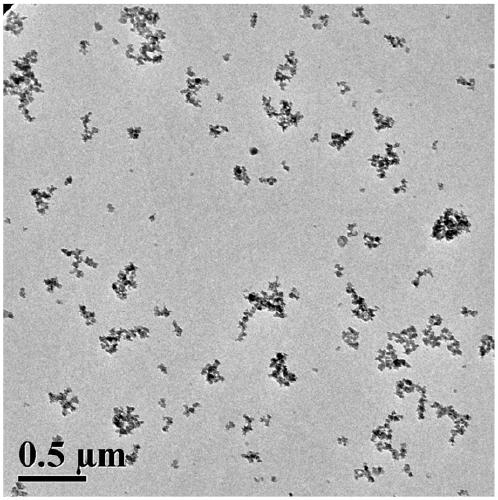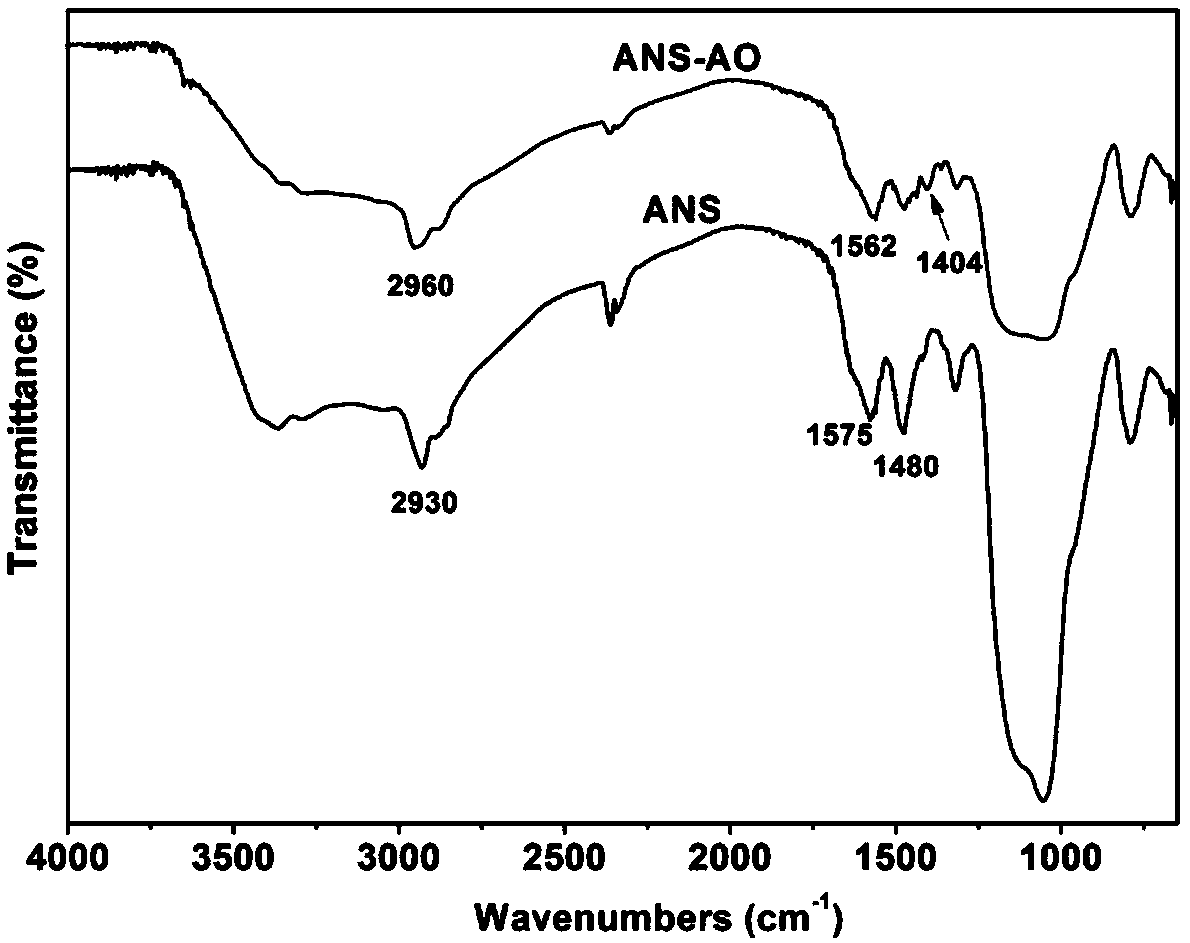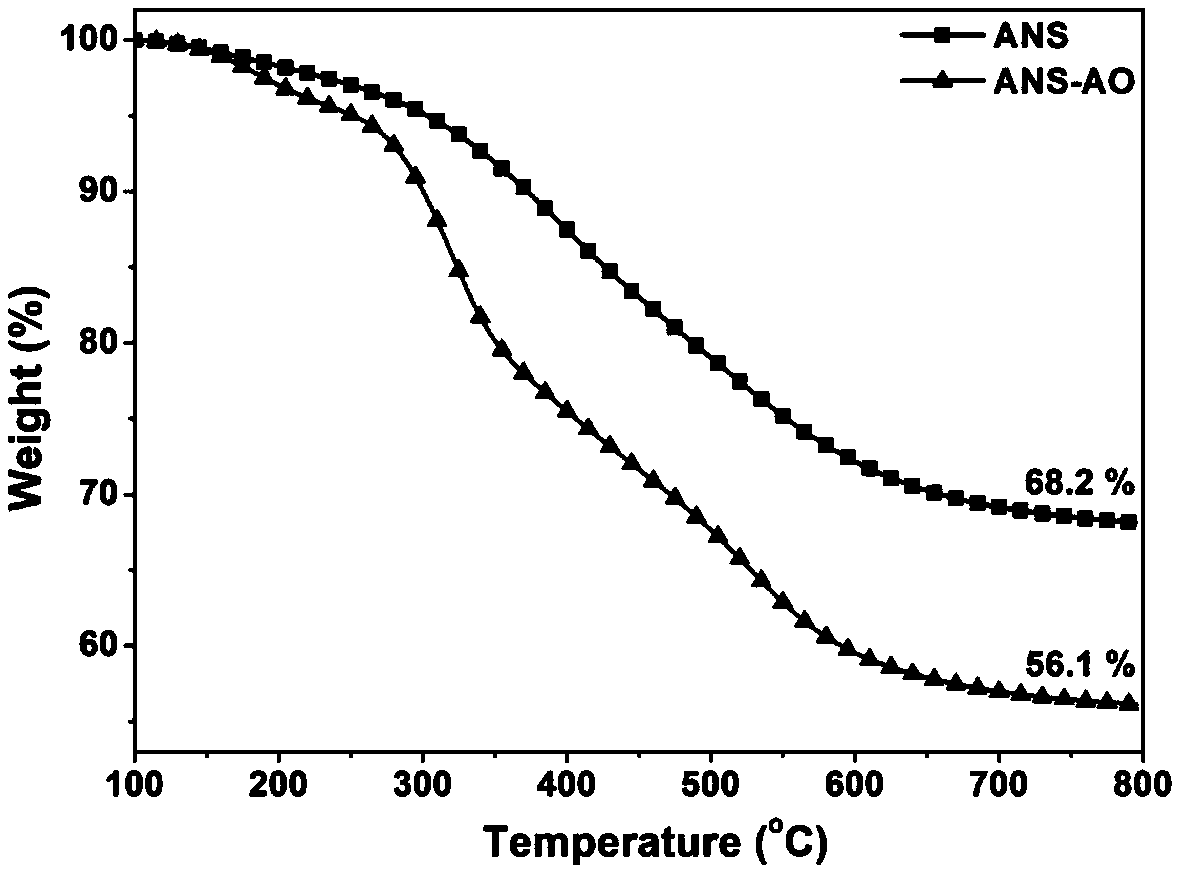Silicon dioxide nanoparticles grafted with organic functional molecules as well as preparation method and application thereof
A technology of nanoparticles and silica, applied in the treatment of dyed low-molecular organic compounds, fibrous fillers, etc., can solve the problems of complex synthesis process, high energy consumption and cost, high synthesis temperature, etc., and achieve high reactivity and low cost , the effect of high grafting rate
- Summary
- Abstract
- Description
- Claims
- Application Information
AI Technical Summary
Problems solved by technology
Method used
Image
Examples
Embodiment 1
[0042] Add 22.4g (0.1mol) N-(β-aminoethyl)-γ-aminopropyltrimethoxysilane and 62.5g (0.3mol) ethyl orthosilicate to 1000ml isopropanol, stir well and add 144ml deionized water, stirred and reacted at room temperature for 6 hours, and centrifuged and dried to obtain aminated silica nanoparticles (ANS).
[0043] Disperse 5.0 g of aminated silica nanoparticles in 200 ml of absolute ethanol, dissolve 10.0 g of 3,5-di-tert-butyl-4-hydroxyphenylpropionic acid (AO) in another 200 ml of absolute ethanol, and then Mix the two and stir evenly, react at room temperature for 12 hours and then filter, wash the filtrate three times with absolute ethanol to remove the ungrafted antioxidant, and dry at 60°C to obtain the bismuth grafted with organic functional molecules. Silicon oxide nanoparticles (ANS-AO), the TEM image of which is shown in figure 1 shown.
[0044] From figure 1 It can be seen from the figure that the silica nanoparticles synthesized by this method present an irregular sh...
Embodiment 2
[0048] Add 35.8g (0.2mol) of γ-aminopropyltrimethoxysilane and 41.7g (0.2mol) of ethyl orthosilicate into 800ml of absolute ethanol, stir well, add 108ml of deionized water, and stir at room temperature for 12 hours , after centrifugal drying, aminated silica nanoparticles were obtained. Disperse 5.0 g of aminated silica nanoparticles in 150 ml of dichloromethane, dissolve 5.0 g of 3,5-di-tert-butyl-4-hydroxybenzoic acid in another 150 ml of dichloromethane, then mix the two and Stir evenly, react at room temperature for 24 hours and then filter, wash the filtrate three times with absolute ethanol to remove ungrafted antioxidants, and dry at 60°C to obtain silica nanoparticles grafted with organic functional molecules , wherein the weight of the grafted hindered phenol molecules accounts for 6.1% of the total weight of the organic functional molecule grafted silica nanoparticles, about 0.26mmol / g.
Embodiment 3
[0050] Add 16.3g (0.1mol) of γ-aminopropylmethyldiethoxysilane and 60.9g (0.4mol) of methyl orthosilicate into 500ml of absolute ethanol, stir well, add 54ml of deionized water, and After stirring and reacting for 20 hours, and centrifuging and drying, aminated silica nanoparticles were obtained. Disperse 5.0 g of aminated silica nanoparticles in 200 ml of ethyl acetate, dissolve 2.0 g of 3,5-di-tert-butyl-4-hydroxybenzoic acid in another 100 ml of ethyl acetate, then mix the two and Stir evenly, filter after reacting at room temperature for 24 hours, wash the filtrate three times with ethanol, remove ungrafted antioxidant, and dry at 60°C to obtain silica nanoparticles grafted with organic functional molecules, wherein The weight of the grafted hindered phenol molecules accounts for 2.3% of the total weight of the organic functional molecule grafted silica nanoparticles, about 0.1 mmol / g.
PUM
| Property | Measurement | Unit |
|---|---|---|
| Particle size | aaaaa | aaaaa |
Abstract
Description
Claims
Application Information
 Login to View More
Login to View More - R&D
- Intellectual Property
- Life Sciences
- Materials
- Tech Scout
- Unparalleled Data Quality
- Higher Quality Content
- 60% Fewer Hallucinations
Browse by: Latest US Patents, China's latest patents, Technical Efficacy Thesaurus, Application Domain, Technology Topic, Popular Technical Reports.
© 2025 PatSnap. All rights reserved.Legal|Privacy policy|Modern Slavery Act Transparency Statement|Sitemap|About US| Contact US: help@patsnap.com



